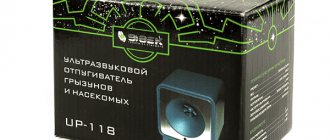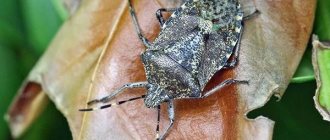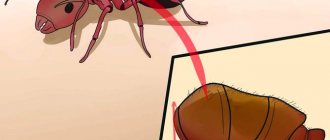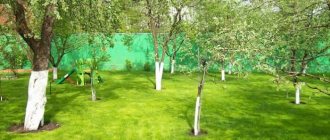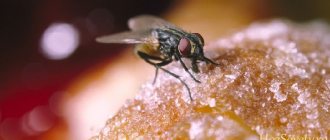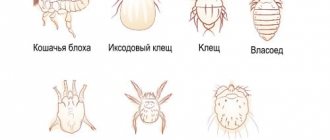Description and appearance of the pest
The bug got its name thanks to the state of Suriname in South America, which is considered the birthplace of the pest, from where it subsequently spread throughout the world. The Suriname mucous beetle (Oryzaephilus surinamensis) belongs to the family of flat beetles.
Their small size, only 1.5–3 mm, flat and elongated body, make these bugs ubiquitous. They can easily fit into the smallest crack. The body is brownish, covered with short hairs. The head protrudes noticeably forward. The antennae are not very long. On the sides of the pronotum there are several teeth, for which the insect is sometimes called a saw beetle. The wings are well developed.
Appearance
The Suriname mukoeater is often confused with its short-whiskered and red-haired counterparts. But these are different types.
The short-whiskered musk beetle (Laemophloeus ferrugineus) is noticeably smaller. The largest individuals barely reach 2.4 mm. It has a dark yellow color.
The red mule beetle (Laemophloeus Cucujus testaceus) is slightly lighter than its Surinamese counterpart, but it is difficult to see this without magnifying devices.
Video
The author of this video offers several tips for combating Suriname mucoeds that appear in malt. However, he believes that contaminated cereals can also be used to brew beer. In his opinion, the taste and quality of the drink does not change.
The author of the following video suggests protecting yourself from the reappearance of the short-whiskered mucous by storing bulk products in closed glass jars, inside of which you should put mint chewing gum.
In this video, it is proposed to destroy the Suriname mucoeda using heat. Namely, by heating the affected product in a microwave oven.
Lifestyle and habitat
Mucoed beetles prefer to live in colonies and often settle next to larger pests. This is explained by the fact that it is difficult for them to chew through the chaff to get to the pulp of the grain. We have to use for food what is left from others. If the colony exists independently, yield losses are much less. In the wild, this quality affects the number of insects, but when it gets to the flour mill, the beetle begins to multiply at an incredible speed.
The pest does not like cold weather and dies at temperatures around zero degrees within 20–30 days. Therefore, in natural conditions, he prefers to live in warm regions where there are no harsh winters. In more northern regions, it lives only in heated premises, where it settles together with food. In the absence of sufficient food, the mucous eater migrates as a whole colony. Often attacks and eats insects smaller than it.
The bug does not like bright light. If you suddenly point a flashlight at him, he will pretend to be dead. The mukoeater behaves in exactly the same way if a dangerous predator appears.
Borax is a proven remedy in the fight against pests.
How to remove the Suriname mucoed, quickly and with improvised means?
You can destroy voracious beetles using means the main component of which is borax - a time-tested component, famous for its effectiveness in the fight against these pests.
Recipe 1. “Borax balls”
Compound:
- Powder made from sugar;
- Millet grains;
- Borax.
Cooking method:
The beans must be ground using a coffee grinder. Mix all ingredients thoroughly with each other in equal proportions. Roll the resulting mass into balls and place them on shelves and cabinets for storing cereals.
Life cycle
Ambient air temperature and humidity affect insect reproduction. When it gets colder than +16°C, reproduction stops. Under optimal conditions, a female can lay up to 600 eggs in her life, but the average is half that.
The female lays eggs in small piles of 25–30 pieces, not particularly caring whether there is food nearby. They can be found not only in products, but also on the surface of furniture and in the cracks of walls. After about two weeks, mucoed larvae hatch from them. They are light in color and very voracious. In addition to the food familiar to adults, the larvae do not ignore the eggs of other insects.
After 18–20 days, pupation occurs. Interestingly, at this stage the mucous eater acquires a number of spines that protect the pupa from predators. A week later, an adult insect is born.
The lifespan of adults reaches 3 years.
Peculiarities of reproduction of red mucoeds
Red mulled beetle
The female lays eggs on the food she feeds on. One individual lays several dozen eggs; there may be 3-5 generations per year. After a few days, white hairy larvae with a reddish tip of the abdomen emerge from the eggs. As they grow, their length reaches 4 mm.
Pupation occurs in a nutrient substrate. The pupa is distinguished by a cream-colored body, 2 spine-like projections at the end and small size - 2.5 mm. The full development cycle from egg to adult is 65-100 days. Adults live for 6 months.
How dangerous is the Surinam mucoed?
Despite their name, flour beetles feed not only on ground wheat grains. They destroy cereals, plant seeds, nuts, cookies, pasta, dried fruits and vegetables. Moreover, all this is eaten not only by adults, but also by larvae. Spoiled foods should not be eaten because:
- They may contain clutches of eggs that are so small that they even pass through a sieve. It is impossible to sift the food or wash it.
- Having settled in the cereal, the Surinamese flour beetle leaves waste there. They are quite toxic and can cause severe allergies in humans.
- The most dangerous thing is that these insects carry fungi and bacteria that can harm human health.
What does the pest eat?
Red flour beetle
In production and warehouse premises, barns, mills, granaries, the red flour beetle gets into the cracks. It feeds on flour, rotten, crushed grains, cereals, and pasta. Only foods whose moisture content exceeds 15% are suitable for insects to eat. Adults can feed on the larvae of other pests, including bark beetles and weevils.
Mucoeds get into the apartment with contaminated products. Small dimensions and flat body structure allow adults and larvae to easily penetrate boxes, bags, bags and other food containers. When it gets into the nutrient substrate, the mucoed begins an active life: feeding and reproducing. Do not ignore the following products:
- cereals, pasta, flour;
- flour and confectionery products;
- dried fruits, nuts, sunflower seeds, flax seeds;
- dried vegetables.
Beetles are very shy and afraid of sunlight and bright light. For the most part, all of the above products are stored in a dark place, which creates favorable conditions for the development of mucoeds. Like many other pests, sensing potential danger, the bug pretends to be dead. Due to its tiny size and immobility, it is mistaken for garbage and sent to the appropriate inventory using a broom. The beetle safely leaves the trash bin and continues to spoil food.
Features of the fight against the Suriname mucoed
High fertility and unpretentiousness in food allows these pests to very quickly infect the entire room where they accidentally entered just a couple of months ago.
Spoiled cereal
The difficulty in getting rid of flour eaters is that it is not enough to throw away spoiled foods. Clutches of eggs can end up anywhere, and after a short time a new, no less voracious generation will emerge from them. You will have to carry out general cleaning, treating all surfaces in the house.
How to get rid of single bugs?
The question of how to get rid of the Suriname mucoed is a question that arises in everyone’s mind, once it is found in the products that have just been brought into the house. You definitely shouldn’t save what you bought. You need to place the cereal in a bag, spray it with insecticide, tie it and immediately take it to the trash can.
If several days have already passed, then the insect has most likely begun to lay eggs. Then all products that could become potential food for the pest should be placed in the freezer for 2–3 days. During this time, both the bug itself and the larvae will die. Cereals can be baked in the oven at +1000C.
A general cleaning by washing all surfaces with a vinegar solution will help get rid of the Suriname mucoed's eggs in the kitchen.
Methods of disposal in case of high degree of infestation
When the flour eater multiplies in the apartment, there is no longer any talk of saving food supplies. We'll have to throw everything away. The house needs to be prepared for the use of pesticides, since repellents cannot be used.
For this:
- Place all foods that bugs do not eat in the refrigerator or seal them tightly.
- Kitchen cabinets are being vacated. The dishes are washed with laundry soap and placed in tightly closed containers.
- Household members and animals are removed from the apartment.
At home, you can get rid of mucousworms using aerosol products used to combat insects. They are convenient because you can direct a stream of insecticide to hard-to-reach places where pest nests may be located.
After spraying, the apartment is left closed for a while and only then is it ventilated and general cleaning done.
Destructive control measures in grain and finished products
Such measures are used as a remedy for the Surinam mucoed when the bug has already entered the storage and processing plant.
- Chemical preparations are used on seed material. Most often, phosphine-based products or contact insecticides are used for these purposes.
- To get rid of mucous beetles in cereals or finished products, thermal methods are used: cooling or heating. Cleaning grain does not give the desired effect, since it only temporarily reduces the number of insects.
Control measures in warehouses and production facilities
Most often, pests multiply at tremendous speed in areas where products are stored and processed, which are the main food of these insects. Methods such as fumigation, gassing, wet or aerosol disinsection help to remove bugs.
Fumigation
Folk remedies on how to get rid of mucoed
Long before the advent of professional remedies, our ancestors fought mucoed with simple folk remedies. These simple ways to get rid of the red mule beetle have not lost their relevance today. The best ones:
- Fill all the cracks in the cabinets with boiling water, then treat with an aqueous solution of vinegar.
- Place a bay leaf or a clove of garlic in a container with cereal or flour; you can enhance the smell by placing the garlic in the corner of the cabinet.
- Beetles cannot tolerate the smell of nutmeg and lavender.
- Pests cannot resist the bait of borax, crushed cereals and powdered sugar; the poisonous mixture kills the parasites.
A good way to get rid of flour beetles in the kitchen are sticky traps in the form of adhesive tape, which are renewed periodically. An effective result is obtained by pyrethrum powder, which can be placed in fabric bags and placed in cabinets. After 1.5–2 weeks, the contents of the bags are renewed. After two treatments, the mucoed will disappear.
Attention! Toxic agents such as borax or pyrethrum should be used with extreme caution, since if they come into contact with food they will become unsuitable for use.
If the pest has managed to get into all the rooms, then after successfully combating it, preventive measures should be taken. The best preventative measure to get rid of mucous in an apartment is to treat each room with a solution of salt and soda. The salt solution blocks the growth of larvae. The inside of the cabinets can be treated with a saline solution. To do this, you need to take a terry towel, wash it in a saline solution, dry it and wipe all the cabinets.
Don't be upset if you find a mucous eater in your home. You can always use professional or folk remedies that will help get rid of it. The main thing is that if you have a supply of flour and cereals in your home, you should regularly carry out preventive inspections in order to identify the pest in time. Then dealing with it will not be difficult.
Prevention
The Surinamese mucous beetle most often enters the home with food purchased at the store. Basic precautions will help avoid the spread of pests in the apartment:
- Flour, cereals, dried fruits, and pasta brought into the house should be immediately placed in the freezer. The best option would be to keep them there for at least a day.
- Bulk products should be stored in glass jars in sunlight. This creates unfavorable conditions for bugs.
- When using canvas bags, they must first be soaked in salt water, dried and ironed. This will repel pests.
- Bay leaves, lavender, garlic and chamomile have repellent properties. Insects try to avoid the places where they are located.
Extermination of insects in production
The Surinamese flour eater is a frequent visitor to production. All food industry enterprises know how to get rid of this dangerous bug. Most often, flour eaters are poisoned with various chemicals that are used to treat production facilities and the grains themselves. These are insecticides and preparations based on hydrogen fluoride.
In addition, heat treatment is used as a means of combating mucoeds. The grains are heated, then cooled and cleaned. After this, the products are left to dry and stored at low temperatures. And before packaging they check carefully.
If all these conditions are met, bugs will not appear . However, very often the quality department in production does not do its job. In this case, the products are not checked, and cleaning measures may not be carried out at all. Therefore, the bugs breed and move into bags of cereals.
After this, the Surinamese mucoed starts to appear in the apartment. Every housewife should know how to get rid of it once and for all, because an unexpected guest can appear at any moment.
Who are mucoeds
Mucoeds are members of the family of flat beetles. The beetles are distinguished by their small, elongated bodies of various shades of brown. The most common species are the Suriname and red mucoed.
The latter are usually light and have a rusty tint, their length is no more than 2 mm. The body is covered with long hairs. On the head there are antennae directed in different directions.
Flour eaters are tiny creatures, but very voracious
Red mucoeds live for about 6 months. Females lay eggs in food, from which larvae hatch a few days later. The larva develops for 3 months, after which it turns into a pupa. During its life, the red mucous eater makes about 5 clutches (up to 100 eggs in total). Its larva is cream-colored and reaches 4 mm in length. At the end of its abdomen there are 2 hook-shaped outgrowths. The pupa is light yellow, with spines at the posterior end. It, like the larva, is covered with hairs.
The Surinam mucoed is darker and longer than the red one. It can reach 3.5 mm in size. The insect's body is covered with short hairs adjacent to the body. The antennae of this mucous eater are short.
In its development, the Suriname mucoed goes through the same stages as most insects: egg, larva, pupa and adult insect
The Suriname mucoed beetle has barbs on its sides, which is why it is called the saw beetle.
Flat grooves stretch along its back. Males are distinguished by the presence of teeth on the lower part of the thighs. The larva of the Suriname mucoede is white or yellow. Her head is brown, and spots of the same color can be seen on her back. The posterior end is slightly rounded. The pupa has 6 spines on the sides, and two straight ones at the end of the abdomen.
Suriname mucoeds live up to three years. The female lays eggs in groups of 30 pieces. After 12 days the larvae hatch. After 3 weeks they pupate and remain in this state for no more than 10 days.
Both Surinamese and red mucoeds can fly
Insects live on almost every continent, but they especially love warm places. The most favorable temperature for their life and development is 23–25 ° C. Air humidity plays an important role. At low temperatures, the mucous beetle stops developing and dies faster.
This insect is very voracious; it damages all food supplies. Flour eaters prefer flour and cereals, but can eat dry animal food, dried fruits, vegetables, pasta and bread products. Bugs mainly appear in barns, granaries, houses and shops.
Flour eaters can settle in bulk cereals, flour, breadcrumbs
By releasing enzymes and leaving feces, mucoeaters can harm human health. Eating contaminated cereals often causes an allergic reaction.
In addition, waste products left by insects contribute to the rapid appearance of mold in stocks.
What to do if there are bugs?
First of all, check all the products. Most often, housewives remember flour and cereals, but insects can hide in other places.
Where to look for bugs?
Bugs are nosy and almost omnivorous insects. Therefore, if you catch your eye at least one, you need to urgently organize an audit and look for them in all sorts of “hiding places”:
- beans - favorite habitat;
- bread;
- flour and cereals;
- dried fruits;
- spices (they even live in pepper bags);
- vegetables (soft rotting onions are a reason to take a closer look);
- tea and coffee;
- cookie;
- cracks in furniture and window sills;
- kitchen appliances;
- first aid kit (bugs are susceptible to mustard plasters).
After a thorough home inspection, you need to do the following:
If few insects are found, some of the products can be saved by calcining them in the oven or keeping them in the freezer for a day (then the flour or cereal must be sifted through a sieve). Heavily contaminated supplies will have to be disposed of.
Legumes need to be immersed in salt water and wait until the beetles and their offspring float to the surface, after which the water should be drained and the grains dried.
The garbage along with the bugs must be taken out immediately before they crawl into the cracks of the floor.
- Place unaffected products into glass jars and close tightly.
- Clear the cabinets of food and rinse with vinegar water (1 teaspoon per liter).
- Disinfect all rooms to prevent insects from breeding. Pouring boiling water into the cracks (for wooden floors) gives good results.
The main thing is to make sure that all insect habitats are declassified.
Food moth - a flying disaster
Have you seen a moth with silver wings and a body 1 cm long in the kitchen? Did you decide that she accidentally flew in, and her goal was woolen items and a fur coat? Perhaps you are mistaken and your products are contaminated.
Habitat and method of reproduction of the food moth
Food moth is an insidious insect! Moths do not spread as quickly as small bugs, but they easily fly from place to place and lay eggs in the most unexpected places.
Moth larvae are often found in wooden cracks in windows and kitchen cabinets. Therefore, when cleaning the kitchen, it is important to thoroughly rinse all cracks and furniture joints.
How to identify food moth?
Moth larvae
The appearance of moths can be detected already in the initial stages. The case is rarely limited to one or two individuals that accidentally flew in from the street.
To see moths, you need to take a close look at kitchen cabinets, mezzanines, walls and ceilings.
Gray-brown cocoons will be visible under the ceiling and on the walls. And pinkish caterpillars are easy to detect in infected cereals and flour.
Once infected, food products become unfit for consumption within a few days, so they can simply be thrown away.
How to get rid of food moths?
- Open all cabinets and ventilate the room. You are lucky if the moth appears in the winter. Is it 20 outside? This is good for you. Open the kitchen window and leave the room in freezing temperatures for 2-3 hours. In spring and summer, ventilation will not help. We'll have to set traps. Place as many sticky traps as possible around the kitchen - while you are sorting through the food, most of the flying moths will be caught.
- Check all food - all damaged food should be thrown away without mercy. Evidence of food contamination by moths is gray pellets in cereals, glued grains, and a greenish coating on the container. If less than 20% of the product is contaminated, it can be saved. To do this, the cereal is placed in the freezer for 2-3 days, or heated in the oven at a temperature above plus 50 degrees. After temperature treatment, the cereal must be sorted, washed and poured into a clean glass container with a lid.
- All furniture and appliances in the kitchen should be thoroughly washed. First time with a soap solution, then with water and vinegar.
- After cleaning, all surfaces should be treated with any chemical moth repellent. Excellent results are given by: Armol, Antimol and Raptor from moths. If moths are found not only in the kitchen, but throughout the apartment, then you will have to spray the anti-moth agent in the corners of the rooms, furniture joints, carpets, fabrics, books and clothes.
Bugs are difficult to control, so it is better to prevent their appearance. The main source of entry of food moths, borers or flour beetles into the house is contaminated food.
It doesn’t matter whether you bought the cereal at the market or in the supermarket - before packaging, the product was stored in large tanks and could be attacked by insects. Primary treatment kills most of the bugs, but their eggs do not lose their viability.
Therefore, any cereal should be washed and dried in the oven, and then poured into a container with a tight lid. Once a month, all cereals should be inspected and thrown away if there is a hint of contamination.
Often, food supplies in our homes are in danger of being spoiled and eaten by various insects. Small beetles called mucoeds cause a lot of trouble. Where do they come from in your home and how to get rid of these annoying roommates?
Insects in cereals
No one is safe from the appearance of insects in cereals. They may appear there while the grain is in the elevator or granary.
And after the products are packaged and ready for sale, they will end up in our kitchens.
Bugs
It is better not to use cereals where insects have infested, but to throw them away to birds or animals.
Mucoeds
Science knows several types of mucoeds. They are not very different from each other in appearance or in the harm they cause. Some differences exist biologically.
Small bugs in cereals
The bug that most often appears in cereals, the Surinam mucoed, is relatively small in size.
Its body reaches 1.8-3.5 millimeters. Its body is elongated and flattened, black-brown in color, the surface of which is matte. Quite short hair growths are adjacent to the chitinous cover.
The loose and flattened head is pushed forward. The mustache, slightly less than half the length of the body, thickens slightly towards the top. In males, on the posterior segments, on the lower part, there is a tiny tooth.
These insects do not have the ability to fly.
The red mukoed reaches a length of one and a half to two and a half millimeters. The body is narrow, rusty-yellow in color, covered with hairs. Thin thread-like antennae of the same length as the body. These beetles have the ability to fly beautifully.
The smallest insect in the class of mucoeds is the short-whiskered mucoed. The size of the body reaches only 1.5-2.4 millimeters. Its narrow body is quite thick and has a rusty-yellow color. The chitinous shell has silky hairs. The beetles have two pairs of wings and fly in calm weather on sunny days.
Bread grinder
These insects are the most voracious and not picky bugs in food. Their cylindrical shape and brown body reaches 4 millimeters in length and is covered with hairs.
Moth larvae also spoil cereals
food moth
In addition to beetles, larvae up to 1 cm long and with a dark-colored head can be found in cereal stocks. These are food moth larvae.
Adult butterflies do not have a mouthpart or a functioning digestive system.
That's why they don't eat. But the larvae cause no less harm to products than bugs.
Prevention of bugs
In order not to fight pests, it is better to protect yourself from their appearance and reproduction in advance. General advice is to keep it clean and ensure that cabinets are periodically ventilated.
If your furniture is quite airtight and the air in it does not circulate well, do regular ventilation by simply opening the cabinets for a short time:
- Try not to make large reserves. This, of course, will not protect you from pests, but it will significantly save your money; if a bug does settle in, you will have to get rid of the products.
- Give preference to airtight glass or plastic containers with tight lids. Only such banks will not be defeated by Khrushchev.
- If you can’t deny yourself this and still stock up on food in bags, then use dust. Herbal dust can be bought at the market, less often in a store, in the insect control department. This product must be sprinkled on the floor, under the bags. Bugs are not suitable for it, and it is absolutely safe for human health.
- Try to differentiate products rather than storing everything together on one shelf. For example, try to keep wet dried fruits away from cereals.
- Use a folk remedy for prevention – garlic. You can put a clove of garlic at the bottom of a jar of cereal. And between the jars, place dried bay leaves, which parasites cannot tolerate.
- If you still store cereals in fabric bags, then “salt” such containers. To do this, you need to prepare a saline solution, about a couple of tablespoons per 1 liter of water, and soak the bags in it. After half an hour, take them out and dry them. Parasites try to avoid such salted bags.
If you still store cereals in fabric bags, then “salt” such containers
Causes and signs of beetles
Having a small and flat body, the beetles hide well from human eyes and easily penetrate packages with food they like.
There are several ways they can get into your home:
- flour eaters can be found in bags with contaminated or rotten flour and cereals;
- insects often live in packages of low-quality pet food;
- the beetle can fly into apartments located near industrial enterprises.
Detecting insects is very simple, just inspect all your supplies and note that:
- a flour-like mass appears at the bottom of packages of cereals;
- flour and cereals become wet;
- black dots (mucoed feces) are found in the products;
- When washing cereals, insects and larvae float to the surface of the water.
When purchasing cereals, be sure to pay attention to the quality and tightness of the packaging.
Preventive actions
The main reason mucoeaters enter a person’s home is the purchase of already contaminated cereals and flour.
These types of products should always be inspected before consumption. All purchased cereals and flour mixtures must be kept in the refrigerator for 2-3 days. It is also necessary to follow the rules for storing food:
- Provide access to sunlight. After all, it is known that the Suriname mucoed does not like exposure to the sun. That is why it is better to store rice, buckwheat, pasta, flour and other such products in glass jars. This will reduce the humidity that mucous eaters love so much.
- It is recommended to place a bay leaf, a sprig of lavender, chamomile flowers or garlic near the location of the flour and cereals.
- If possible, store dried fruits and nuts in the refrigerator.
- Cereals can be fried and packaged in sealed bags.
It is also recommended to wash all cabinets regularly with a vinegar solution.
This will get rid of crumbs and other debris. If there are cracks and cracks in the house, they need to be closed to limit the entry of various insects into the house.
Prevention is also very important for grain storage facilities, as well as food warehouses. Before receiving grain, flour and pasta, warehouses are carefully processed, and the products themselves are inspected for the presence of mucoed. The grains themselves are cleaned of debris and grains with defects.
Of course, it is better to prevent the appearance of pests in the home and industrial enterprises than to fight them for a long time and persistently, wasting your time, effort and financial resources.
Insects in cereals
No one is safe from the appearance of insects in cereals. They may appear there while the grain is in the elevator or granary.
And after the products are packaged and ready for sale, they will end up in our kitchens.
Bugs
It is better not to use cereals where insects have infested, but to throw them away to birds or animals.
Mucoeds
Science knows several types of mucoeds. They are not very different from each other in appearance or in the harm they cause. Some differences exist biologically.
Small bugs in cereals
The bug that most often appears in cereals, the Surinam mucoed, is relatively small in size.
Its body reaches 1.8-3.5 millimeters. Its body is elongated and flattened, black-brown in color, the surface of which is matte. Quite short hair growths are adjacent to the chitinous cover.
The loose and flattened head is pushed forward. The mustache, slightly less than half the length of the body, thickens slightly towards the top. In males, on the posterior segments, on the lower part, there is a tiny tooth.
These insects do not have the ability to fly.
The red mukoed reaches a length of one and a half to two and a half millimeters. The body is narrow, rusty-yellow in color, covered with hairs. Thin thread-like antennae of the same length as the body. These beetles have the ability to fly beautifully.
The smallest insect in the class of mucoeds is the short-whiskered mucoed. The size of the body reaches only 1.5-2.4 millimeters. Its narrow body is quite thick and has a rusty-yellow color. The chitinous shell has silky hairs. The beetles have two pairs of wings and fly in calm weather on sunny days.
Bread grinder
These insects are the most voracious and not picky bugs in food. Their cylindrical shape and brown body reaches 4 millimeters in length and is covered with hairs.
Moth larvae also spoil cereals
food moth
In addition to beetles, larvae up to 1 cm long and with a dark-colored head can be found in cereal stocks. These are food moth larvae.
Adult butterflies do not have a mouthpart or a functioning digestive system.
That's why they don't eat. But the larvae cause no less harm to products than bugs.


